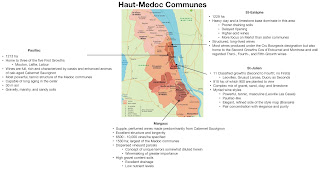Our Orlando Tasting Group has recently held vertical tasting events focused on the Pauillac wines of Pichon Baron and Comtesse de Lalande and are about to embark on the tasting of a third -- Château Lynch-Bages. Before we do, however, I would like to take a step back and explore the larger context within which these chateaux operate.
Pauillac - the home appellation of these three estates -- exists within a larger geographical construct called the Medoc (illustrated below) which owes its winemaking prowess to (i) a temperate climate (characterized by humid springs, hot summers, sunny autumns, and relatively mild winters) and (ii) its gravelly soils.
The region's growing conditions are favorably impacted by the climate modifiers detailed in the chart below.
The Medoc is divided into two sub-appellations: Medoc, to the north, and Haut-Medoc, with the former covering 4700 ha and the latter 4300. The Medoc sub-appellation, called Bas Medoc in earlier times, has heavy, moisture-retaining soils which are much more suited to Merlot than the Cabernet Sauvignon which dominates in its neighbor to the south.
Within the Haut-Medoc appellation there are four communal appellations renowned for producing some of the finest wines in the world. We will focus on this appellation and its communes in the remainder of this post.
The chart below provides an overview of the Haut-Medoc landscape and illustrates how its constituent parts function as an integrated draining mechanism.
Many areas in the Haut-Medoc have large deposits of gravel which were washed down from the Pyrenees thousands of years ago. This gravel provides excellent drainage and ideal conditions for Cabernet Sauvignon which does not like "wet feet." These gravelly soils retain warmth and, in so doing, aid in the ripening of the grapes. The characteristics of the soils at the commune level are detailed in the chart below.
With the treatment of this broader context complete, we can now resume our tasting of the commune wines.





No comments:
Post a Comment